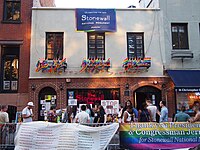
Photo from wikipedia
Abstract Events, predominantly sport mega-events, have received an abundance of academic scrutiny. Some of these commentaries have critiqued how the staging of mega-events can violate a range of universal human… Click to show full abstract
Abstract Events, predominantly sport mega-events, have received an abundance of academic scrutiny. Some of these commentaries have critiqued how the staging of mega-events can violate a range of universal human rights. Far less is available that is concerned with how events are mobilised for human rights advocacy. This paper, drawing from an ongoing qualitative research project (Baltic Pride 2015–2017), focuses on the venacularisation of human rights to offer a view of the intricacies of LGBT (lesbian, gay, bisexual and transgender) activism at the level of the local. Discussion starts with an appraisal of existing universal human rights policies surrounding sexual orientation and gender identity (SOGI), specifically United Nations (UN) and European Union (EU) legislative frameworks. This legislative premise is followed by a focus on vernacularisation; a concept that reveals the complicated processes of human rights claiming. A brief history of Baltic Pride provides the context for EuroPride 2015 as well as the subsequent analyses of research findings, which are explored through the themes: EuroPride 2015 Pride House and EUroPride’s Super VIPs. Methodologically, the research relies on a combination of ethnography and autoethnogarphy, and findings are embedded within the critical analyses. Photographs, field notes that are more akin to autoethnographic narrative and commentary from the interview participants help highlight the conceptual value of vernacularisation to research on human rights.
Journal Title: Leisure Studies
Year Published: 2018
Link to full text (if available)
Share on Social Media: Sign Up to like & get
recommendations!